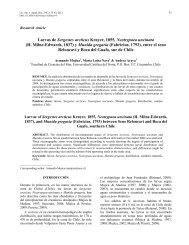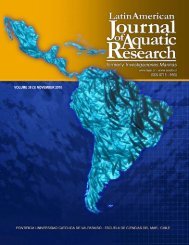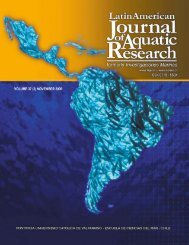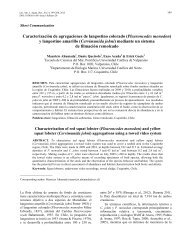Portada LAJAR-2013 (1).psd - Latin American Journal of Aquatic ...
Portada LAJAR-2013 (1).psd - Latin American Journal of Aquatic ...
Portada LAJAR-2013 (1).psd - Latin American Journal of Aquatic ...
Create successful ePaper yourself
Turn your PDF publications into a flip-book with our unique Google optimized e-Paper software.
Lat. Am. J. Aquat. Res., 41(1): 42-56, <strong>2013</strong> Macr<strong>of</strong>auna <strong>of</strong> São Sebastião Channel, Southeastern Brazil<br />
DOI: 103856/vol41-issue1-fulltext-3<br />
Research Article<br />
Spatial pattern <strong>of</strong> benthic macr<strong>of</strong>auna in a sub-tropical shelf, São Sebastião<br />
Channel, southeastern Brazil<br />
Ana Maria S. Pires-Vanin 1 , Emilia Arasaki 2 & Pablo Muniz 3<br />
1 Instituto Oceanográfico, Universidade de São Paulo, Praça do Oceanográfico 191<br />
São Paulo, 05508-120, Brasil<br />
2 Escola Politécnica, Universidade de São Paulo. Av. Pr<strong>of</strong>. Mello Moraes 2231, São Paulo, Brasil<br />
3 Oceanografía y Ecología Marina, Facultad de Ciencias, Universidad de la República<br />
Iguá 4225, Montevideo, 11400, Uruguay<br />
ABSTRACT. Diversity and community organization <strong>of</strong> the benthic macr<strong>of</strong>auna were investigated along the<br />
São Sebastião Channel, northern coast <strong>of</strong> São Paulo State, Brazil, and related to sedimentary variables and<br />
organic load. These important outstanding s<strong>of</strong>t bottom benthic habitats are characterized by their close<br />
proximity to sources <strong>of</strong> human impact. Sampling was undertaken seasonally, using a Van Veen grab (0.1 m 2 )<br />
in 15 oceanographic stations, from November 1993 to August 1994. A total <strong>of</strong> 392 species were recorded and<br />
polychaetes completed nearly 50% <strong>of</strong> the fauna. Twenty three species were most numerous and frequent and<br />
comprised the baseline pool for the area. Sites were classified with respect to sediments in three site-groupings<br />
according to Arasaki et al. (2004). The finest-sediment site-group had significantly fewer species than coarser<br />
site-groups. The stations locate at the south opening and in the axis <strong>of</strong> the channel presented sediments with<br />
organic matter predominantly <strong>of</strong> marine origin, indicating the flow <strong>of</strong> open sea waters across the channel.<br />
These places showed also higher values <strong>of</strong> diversity and species richness. The site-group located along the<br />
insular side and in the channel north mouth, stood out for the significantly higher density. Although its relative<br />
small area the channel presented species richness similar to that found in the adjacent inner continental shelf.<br />
Comparisons between channel and adjacent shelf habitats are addressed in the light <strong>of</strong> ecological data.<br />
Keywords: diversity, macr<strong>of</strong>auna, continental shelf, São Sebastião Channel, Brazil, South Atlantic Ocean.<br />
Aspectos ecológicos de la macr<strong>of</strong>auna bentónica del Canal de São Sebastião,<br />
sudeste de Brasil<br />
RESUMEN. Se estudió la organización y diversidad de la comunidad macrobentónica de fondos blandos del<br />
canal de São Sebastião, costa norte del Estado de São Paulo, Brazil, relacionándolo con variables<br />
sedimentológicas y carga orgánica del sedimento. Estos fondos marinos importantes para especies bentónicas<br />
se caracterizan por encontrarse próximos a fuentes de impacto antrópico. El muestreo se desarrolló<br />
estacionalmente a lo largo de un año, en 15 estaciones oceanográficas, con una draga Van Veen (0.1 m 2 ),<br />
desde noviembre de 1993 hasta agosto de 1994. Se identificó un total de 392 especies, correspondiendo los<br />
poliquetos aprox. al 50% de la fauna. De este total, 23 especies fueron las más abundantes y frecuentes. Las<br />
estaciones fueron clasificadas según el sedimento en tres grupos de acuerdo con Arasaki et al. (2004). El<br />
grupo de estaciones caracterizado por sedimentos finos presentó significativamente menos especies que los<br />
otros dos grupos. Las estaciones localizadas en el extremo sur del canal y en su eje longitudinal presentaron<br />
sedimentos con materia orgánica predominantemente de origen marino, reflejando el flujo de aguas del océano<br />
abierto a través del canal. Estas estaciones mostraron también mayores valores de diversidad y riqueza de<br />
especies. Por otro lado, el grupo de estaciones localizado del lado insular y en la boca norte del canal presentó<br />
mayores densidades. A pesar de ser un área relativamente pequeña, el ecosistema del canal de São Sebastião<br />
presentó una riqueza de especies semejante a la registrada en la plataforma continental interna adyacente. La<br />
comparación de ambos ecosistemas se discute considerando los datos ecológicos disponibles.<br />
42







